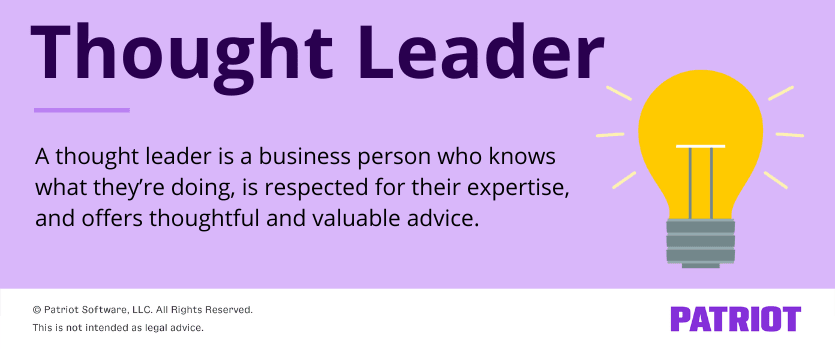The term thought leader seems to be everywhere online. News articles. LinkedIn posts. Everyone has thought leadership examples or is racing to offer the next best thought leader definition. But if you haven’t heard of it, you may be scratching your head. Read on to learn what’s a thought leader and how to become one.

What’s a thought leader?
Joel Kurtzman coined the term thought leader in 1994 when he was editor-in-chief of Strategy + Business magazine. At the time, here’s the definition he provided: “A thought leader is recognized by peers, customers and industry experts as someone who deeply understands the business they are in, the needs of their customers and the broader marketplace in which they operate. They have distinctively original ideas, unique points of view and new insights.”
To put the thought leader definition simply, a thought leader is a business person who knows what they’re doing, is respected for their experience and expertise, and offers thoughtful and valuable advice.
Modern thought leadership
Thought leadership now is a bit different than when Kurtzman first coined the term. Nowadays, thought leadership is often seen as a way to strengthen your brand. Semrush notes that thought leadership “is the delivery of authentic and genuine content that uses expertise, insight, and experience of the author, with the goal of sharing that wisdom with others.”
Think of becoming a thought leader as a specific way to engage across social media platforms by presenting usable and inspiring content that foregrounds your expertise and experience.
What thought leadership isn’t: Thought leadership isn’t about being the loudest voice in the room (or online). Opinions, hot takes, and jumping headfirst into a debate don’t make someone a thought leader.
Why is thought leadership important?
The business world needs thought leaders for many different reasons. But, the most important is that people in all industries need trustworthy information, timely inspiration, and leaders in their field. Running a business of any size can be difficult, nerve-wracking, and feel like an impossible task. Thought leaders can help companies thrive, help business owners find their way in a sea of choices, and make the impossible seem possible.
And, becoming a thought leader can be a great way to boost your brand, expand your reach on social media, and give something back to your business community.
How to become a thought leader
Becoming a thought leader can take some time, but it isn’t impossible. If you’re wondering how to become a thought leader, follow our four tips to get started.
1. Stick to what you know
A huge part of being a thought leader is being genuine and sticking to what you know.
For instance, if you know the best fishing lure to use when it’s cloudy outside (spinnerbaits, wobbling jigs, and crankbaits work great) and you sell fishing equipment, spread the word. Somewhere a customer is looking at the sky and wondering what to pull out of their tackle box. And there’s a chance that your competitors might not have your expertise.
Share what you know and be authentic. Your knowledge, honesty, and authenticity will go a long way to helping you become a thought leader.
2. Expand your online presence
Becoming a thought leader isn’t just about having the knowledge and expertise. It’s also about sharing knowledge with others. Social media and personal websites can give thought leaders multiple opportunities and formats to share their knowledge.
Here are a few tips to keep in mind as you expand your thought leadership online.
Generate helpful, timely content that’s easy to understand
Sharing information means generating content. How you do that is up to you. Possible choices include informational videos (long and short form), blog posts, photo essays, and podcasts. Pick whichever formats you feel comfortable doing. For instance, you may not feel up to a 15-minute video on YouTube, but a quick 50-second video on TikTok may be right up your alley.
Whichever form of media you choose, ensure that your content is helpful for your audience, to the point, and thorough. You want your audience to feel educated (hopefully without being bored!), and you want them to come back to you for more information in the future.
If you have a unique tone or style, all the better. Your audience will remember your content not just because it was helpful, but because it was also interesting and exciting.
Use SEO to your advantage
Don’t get lost in the internet weeds. Search engine optimization (SEO) helps your content appear in organic search results. The great news is that SEO is a free tool to get your content in front of your audience. It may take a little work and time, but SEO practices can set you apart from other thought leaders.
To improve your SEO, do some keyword research. There are two ways to look at keywords:
- Keywords are the search queries people put into search engines and the search functions of social media platforms.
- Keywords are what content creators use to help bring people to their site.
Learn what keywords people are searching for that deal with your expertise. Then, you can make content around those words and use them in titles, headings, and your copy.
Connect with other thought leaders
Being a thought leader isn’t about competing with other thought leaders. It’s about being part of a larger community and helping others. You may also find a mentor that you can learn from to make yourself better at what you do.
3. Share your knowledge offline
Speaking engagements that happen offline can significantly increase your street credibility (and your online credibility as well!). While public speaking may not be your forte, you don’t have to start worrying about giving a Ted Talk just yet.
Start small and see what happens. Local business groups, like the Chamber of Commerce or a Rotary Club, can help you practice and network with people in your area. And depending on your business, speaking to a local school may be a great fit.
Refine your ideas, craft your query letters, and see who’s interested in what you have to say.
Want to impress your friends at a dinner party?
Get the latest small business news delivered straight to your inbox.
Subscribe to Email List4. Don’t forget to keep learning
Being a thought leader isn’t just about what you know; it’s also about your willingness to stay up-to-date and keep learning. After all, you must always have something new and vital to say if you want to stay a thought leader.
Follow other thought leaders, do the research, and read all the books you can on your subject.
If you are half as good at learning new content as you are at sharing it, you’ll be a thought leader in no time and stay one step ahead of everyone else.
Thought leadership examples
Just in case you need a model to fashion your new thought leadership life around, here are a few examples of thought leaders in the business world:
- Gary Vaynerchuk: Vaynerchuk is a serial entrepreneur who is currently the CEO of Vaynermedia and VeeFriends, the chairman of Vaynerx, and a New York Times Bestselling author. Vaynerchuk’s books offer personal insight from years of experience and focus on connecting with customers through social media and other platforms.
- Neil Patel: Patel is the co-founder of Crazy Egg and KISSmetrics. Patel helps companies improve their online marketing and increase their revenue.
This is not intended as legal advice; for more information, please click here.



